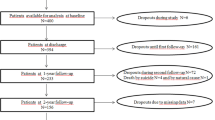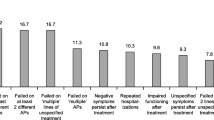Abstract
Objective
Relapse prevention is the main goal of maintenance treatment in schizophrenia. This study aimed to determine the rate and the socio-demographic and clinical predictors of relapse in Chinese schizophrenia patients following treatment of the acute phase of the illness.
Methods
In a multi-center, randomized, controlled, longitudinal study, 404 patients with schizophrenia who were clinically stabilized following an acute episode were randomly assigned to either the maintenance (i.e., initial optimal therapeutic doses continued throughout the study) or the dose-reduction group (i.e., initial optimal therapeutic doses continued for 4 or 26 weeks followed by a 50% dose reduction that was maintained until the end of the study). Participants were interviewed at entry using standardized assessment instruments, and followed up for 12–26 months.
Results
In univariate analyses, relapse was significantly associated with the membership of the dose-reduction group, poor medication adherence, and having a diagnosis of the paranoid type of schizophrenia. In Cox proportional-hazards regression analysis the membership of the dose-reduction group, poorer medication adherence, more severe drug-induced side effects and prominent paranoid symptoms independently predicted a higher risk of relapse.
Conclusion
The study confirmed the importance of maintenance medication in preventing relapse in Chinese schizophrenia patients underscoring the risk of relapse associated with lack of treatment adherence, severe side effects and the patients’ paranoid attitude. Socio-demographic characteristics were not associated with relapse in Chinese schizophrenia patients. Potential residual confounding caused by unmeasured variables should be fully considered in future studies.

Similar content being viewed by others
References
Gaebel W, Riesbeck M (2007) Revisiting the relapse predictive validity of prodromal symptoms in schizophrenia. Schizophr Res 95:19–29
Lieberman JA, Perkins D, Belger A, Chakos M, Jarskog F, Boteva K, Gilmore J (2001) The early stages of schizophrenia: speculations on pathogenesis, pathophysiology, and therapeutic approaches. Biol Psychiatry 50:884–897
Weiden PJ, Olfson M (1995) Cost of relapse in schizophrenia. Schizophr Bull 21:419–429
Hugenholtz GW, Heerdink ER, Meijer WE, Stolker JJ, Egberts AC, Nolen WA (2005) Reasons for switching between antipsychotics in daily clinical practice. Pharmacopsychiatry 38:122–124
Rantanen H, Koivisto AM, Salokangas RK, Helminen M, Oja H, Pirkola S, Wahlbeck K, Joukamaa M (2009) Five-year mortality of Finnish schizophrenia patients in the era of deinstitutionalization. Soc Psychiatry Psychiatr Epidemiol 44:135–142
Chen EY, Hui CL, Dunn EL, Miao MY, Yeung WS, Wong CK, Chan WF, Tang WN (2005) A prospective 3-year longitudinal study of cognitive predictors of relapse in first-episode schizophrenic patients. Schizophr Res 77:99–104
Xiang Y, Weng Y, Li W, Gao L, Chen G, Xie L, Chang Y, Tang WK, Ungvari GS (2006) Training patients with schizophrenia with the community re-entry module: a controlled study. Soc Psychiatry Psychiatr Epidemiol 41:464–469
Beiser M, Bean G, Erickson D, Zhang J, Iacono WG, Rector NA (1994) Biological and psychosocial predictors of job performance following a first episode of psychosis. Am J Psychiatry 151:857–863
Doering S, Muller E, Kopcke W, Pietzcker A, Gaebel W, Linden M, Muller P, Muller-Spahn F, Tegeler J, Schussler G (1998) Predictors of relapse and rehospitalization in schizophrenia and schizoaffective disorder. Schizophr Bull 24:87–98
Gilbert PL, Harris MJ, McAdams LA, Jeste DV (1995) Neuroleptic withdrawal in schizophrenic patients. A review of the literature. Arch Gen Psychiatry 52:173–188
Hershon HI, Kennedy PF, McGuire RJ (1972) Persistence of extra-pyramidal disorders and psychiatric relapse after withdrawal of long-term phenothiazine therapy. Br J Psychiatry 120:41–50
Jonsson H, Nyman AK (1991) Predicting long-term outcome in schizophrenia. Acta Psychiatr Scand 83:342–346
Mortensen PB, Eaton WW (1994) Predictors for readmission risk in schizophrenia. Psychol Med 24:223–232
Robinson D, Woerner MG, Alvir JM, Bilder R, Goldman R, Geisler S, Koreen A, Sheitman B, Chakos M, Mayerhoff D, Lieberman JA (1999) Predictors of relapse following response from a first episode of schizophrenia or schizoaffective disorder. Arch Gen Psychiatry 56:241–247
Zander KJ, Fischer B, Zimmer R, Ackenheil M (1981) Long-term neuroleptic treatment of chronic schizophrenic patients: clinical and biochemical effects of withdrawal. Psychopharmacology (Berl) 73:43–47
Scottish Schizophrenia Research Group (1992) The Scottish first episode schizophrenia study. VIII. Five-year follow-up: clinical and psychosocial findings. Br J Psychiatry 161:496–500
Cheng XG, Xu H (2001) Analyses on related factors in relapse of schizophrenics (in Chinese). Mod Rehabil 5:30–31
Ding LJ (2007) Correlates of relapse in schizophrenia patients (in Chinese). Med J Chin People Health 19:481–482
Huang LG, Ye P, Zhu CF (2006) Comparison of risk factors of relapse in schizophrenia patients between urban and rural areas (in Chinese). Med J Chin People Health 18:203–204
Jia XS (2006) Analyses on factors of relapse in 579 rehospitalized schizophrenic patients (in Chinese). J Clin Psychosom Disord 12:243–244
Jiang LP (2004) Correlates of relapse in first-episode schizophrneia patients (in Chinese). Chin J Health Psychol 12:368–369
Meng YL, Guo H (2008) Related factor analysis on 98 re-onset patients with schizophrenia (in Chinese). Chin J Health Psychiatry 16:128–129
Xu ML, Peng HY (1997) Multiple factors for relapse in schizophrenia patients (in Chinese). Zhongyuan Mental Health 3:73–75
Zhang LP (2008) The study on clinical high risk factors of intractable schizophrenia (in Chinese). World Health Digest 5:240–242
Hu SF, Han XL, Yang QL, Wu XQ (2000) Risk factor for relapse in schizophrenia patients (in Chinese). Chin J Nerv Ment Dis 26:298–299
Liu TQ, Yang DS, Wang XP, Hao W (2000) Factors associated with schizophrenic relapse: one year follow-up study (in Chinese). Chin J Nerv Ment Dis 26:265–267
Weng YZ, Xu MJ, Li DL, Guo FY, Huang Q, Fu T (2001) Assessment of expressed emotion in family members of schizophrenic patients in Beijing. Mod Rehabil 5:39–42
Wang CY, Xiang YT, Cai ZJ, Weng YZ, Bo QJ, Zhao JP, Liu TQ, Wang GH, Weng SM, Zhang HY, Chen DF, Tang WK, Ungvari GS (2010) Risperidone maintenance treatment in schizophrenia: a randomized, controlled trial. Am J Psychiatry 167:676–685
Altman DG, Schulz KF (2001) Statistics notes: concealing treatment allocation in randomised trials. BMJ 323:446–447
Csernansky JG, Mahmoud R, Brenner R (2002) A comparison of risperidone and haloperidol for the prevention of relapse in patients with schizophrenia. N Engl J Med 346:16–22
He YL, Zhang MY (1997) The positive and negative syndrome scale (PANSS) and its application (in Chinese). J Clin Psychiatry 7:353–355
Marder SR, Davis JM, Chouinard G (1997) The effects of risperidone on the five dimensions of schizophrenia derived by factor analysis: combined results of the North American trials. J Clin Psychiatry 58:538–546
National Institute of Mental Health (1985) TESS (Treatment Emergent Symptom Scale-Write-in). Psychopharmacol Bull 21:1069–1072
Dossenbach M, Arango-Davila C, Silva Ibarra H, Landa E, Aguilar J, Caro O, Leadbetter J, Assuncao S (2005) Response and relapse in patients with schizophrenia treated with olanzapine, risperidone, quetiapine, or haloperidol: 12-month follow-up of the Intercontinental Schizophrenia Outpatient Health Outcomes (IC-SOHO) study. J Clin Psychiatry 66:1021–1030
Leucht S, Barnes TR, Kissling W, Engel RR, Correll C, Kane JM (2003) Relapse prevention in schizophrenia with new-generation antipsychotics: a systematic review and exploratory meta-analysis of randomized, controlled trials. Am J Psychiatry 160:1209–1222
Marder SR, Glynn SM, Wirshing WC, Wirshing DA, Ross D, Widmark C, Mintz J, Liberman RP, Blair KE (2003) Maintenance treatment of schizophrenia with risperidone or haloperidol: 2-year outcomes. Am J Psychiatry 160:1405–1412
Lipkovich I, Deberdt W, Csernansky JG, Buckley P, Peuskens J, Kollack-Walker S, Zhang Y, Liu-Seifert H, Houston JP (2007) Predictors of risk for relapse in patients with schizophrenia or schizoaffective disorder during olanzapine drug therapy. J Psychiatr Res 41:305–310
McCann TV, Boardman G, Clark E, Lu S (2008) Risk profiles for non-adherence to antipsychotic medications. J Psychiatr Ment Health Nurs 15:622–629
Zhang J, LU Z (2008) Correlates of relapse in schizophrenia patients (in Chinese). Shanghai Arch Psychiatry 20:811–813
Lehman AF, Kreyenbuhl J, Buchanan RW, Dickerson FB, Dixon LB, Goldberg R, Green-Paden LD, Tenhula WN, Boerescu D, Tek C, Sandson N, Steinwachs DM (2004) The Schizophrenia Patient Outcomes Research Team (PORT): updated treatment recommendations 2003. Schizophr Bull 30:193–217
Kampman O, Lehtinen K (1999) Compliance in psychoses. Acta Psychiatr Scand 100:167–175
Schneeweiss S, Setoguchi S, Brookhart MA, Kaci L, Wang PS (2009) Assessing residual confounding of the association between antipsychotic medications and risk of death using survey data. CNS Drugs 23:171–180
Acknowledgments
This study was supported by grants from the 10th National Five-Year Plan Foundation of the Ministry of Science and Technology Program, People’s Republic of China (No. 2004BA720A22), the Research Foundation of the Xian-Janssen Pharmaceutical Company (No. RIS-CN-MCCT-0201), the National Natural Science Foundation of China (No. 30800367), and the Beijing Nova Program of the Beijing Municipal Science and Technology Commission (No. 2008B59).
Conflict of interest
None.
Author information
Authors and Affiliations
Corresponding author
Rights and permissions
About this article
Cite this article
Xiang, YT., Wang, CY., Weng, YZ. et al. Predictors of relapse in Chinese schizophrenia patients: a prospective, multi-center study. Soc Psychiatry Psychiatr Epidemiol 46, 1325–1330 (2011). https://doi.org/10.1007/s00127-010-0304-1
Received:
Accepted:
Published:
Issue Date:
DOI: https://doi.org/10.1007/s00127-010-0304-1




